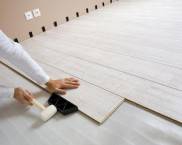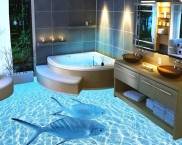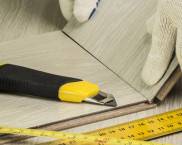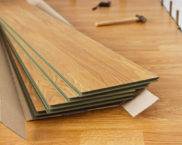Semi-dry floor screed: pros and cons
The main components of a semi-dry floor screed are cement, sand and reinforcing fibers. The use of this technology allows you to form a flat surface without a lot of time and money. The peculiarities of the type of screed under consideration are the relatively short periods of acquisition of the necessary physical properties. If the tie layers made using "wet" technology allow work to be carried out after two to four weeks, then with semi-dry screeds, you can work in four days. As a result, the consumer receives a monolithic base for the manufacture of the floor, practically not amenable to configuration change.
The content of the article
Pros of a semi-dry floor screed
Experts attribute the following factors to the main advantages of the tightening layers made using the technology under consideration:
- For the manufacture of a semi-dry type of screed, a minimum amount of water is required. This allows you to minimize the drying time of the tightening layer, and also provides the ability to quickly carry out work on leveling the mounted surface;
- The use of "semi-dry" technology for the production of the tightening layer allows to obtain an almost perfectly flat surface. As a rule, self-leveling fluids are not required for final leveling.
- The constituent components of "semi-dry" mixtures allow obtaining a surface that practically does not shrink during the drying process, and is also not prone to cracking;
- Due to the presence of reinforced fibers, the semi-dry floor screed, the pros and cons of which make it possible to use it to create floor coverings in buildings for various purposes, is laid on the surface with a minimum layer, which does not affect the strength, resistance to mechanical stress and the ability to withstand mechanical stress of a certain intensity;
- The use of reinforcing components in the composition of the type under consideration can significantly reduce its weight.The use of such a technological solution can significantly reduce the level of load on the supporting structures of the building. Tie layers made of sand and cement do not allow these possibilities.
It is also necessary to note the fact that during the manufacture of the considered constricting layer, one should not be afraid of the moisture contained in the prepared mixture seeping into the rooms located below. A semi-dry floor screed is laid, the pros and cons of which must be taken into account by the master, in most cases using special mechanical means that facilitate the entire range of work, as well as contribute to the manufacture of a high quality surface.
A semi-dry type screed can be laid on wooden floors (in buildings of old projects), concrete surfaces, well-compacted soil made of sand or sand with the addition of gravel. To give the screed of this type of greater strength, reinforcement with a metal mesh is often used, or adding to the mixture fiberglass.
Cons of a semi-dry floor screed
Along with the undoubted advantages, the tightening layer made by semi-dry technology has its own disadvantages. Among them, experts include:
- Reduced fluidity of the working mass. In this regard, mixing the mixture requires the use of special tools;
- Making a semi-dry screed by hand is not easy. The high-quality implementation of measures for laying the mixture depends not so much on the high grade of the composition used, but on the envisaged and unconditional compliance with the requirements of its manufacture and installation. Practice shows that the desire to make a solution that will be more liquid and fluid, by adding an excess amount of water to it, leads to undesirable consequences in the form of poor-quality flooring and additional material costs;
- The laid semi-dry floor screed, the pros and cons of which contribute to its widespread use, is sensitive to moisture. If water enters the surface of the semi-dry type of tightening layer, in which the hydration process is not completely completed, due to lack of moisture, this contributes to further swelling of the cement and the appearance of cracks.
- Sometimes it is impossible to achieve the necessary compaction of the semi-dry constriction layer, as a result of which its partial destruction occurs under the manufactured floor covering, or noise appears in the assembled wooden floorboards.
Semi-dry screed for warm water floors
Arrangement of water-type underfloor heating using a semi-dry tightening layer is a significantly safe and practical method of arranging premises, compared to warm floors electric.
The use of a semi-dry screed allows you to reliably cover pipes with coolantand also protect them from external influences. To this should also be added the resistance of the tightening semi-dry layer to significant temperature changes, as well as the possibility of expansion when the surface is heated. After final installation, and the first start-up, a semi-dry screed for a warm water floor lends itself to heating, retaining its original physical characteristics, strength and resistance to external mechanical stress and damage.
The main condition for the high-quality formation of a warm floor of a water type is the correct calculation of the required thickness of the screed, which can be from three to five centimeters, based on the quality of the base, the bearing capacity of the structure and the structural features of the structure. The tightening layer of three centimeters makes it possible to obtain a solid surface, which is very difficult to achieve when forming a semi-dry type of screed, the thickness of which is five centimeters or more.To increase the strength of the semi-dry tightening layer, experts recommend adding a certain amount of expanded clay to the prepared solution, due to which the composition acquires only high strength, but also reduces its weight.
Considering the above, it should be noted that the use of semi-dry constricting mixtures can significantly reduce the time for arranging floor coverings and get a high-quality, durable surface at a relatively low cost. At the same time, for laying semi-dry mixes, you will need certain special equipment and some skills.
Comparative video review of the classic and semi-dry floor screed






















